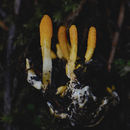en
names in breadcrumbs


Cordyceps militaris is a species of fungus in the family Cordycipitaceae, and the type species of the genus Cordyceps. It was originally described by Carl Linnaeus in 1753 as Clavaria militaris.[1]
The fungus forms 1–8 cm high, club-shaped[2] and orange/red fruiting bodies, which grow out of dead underground pupae. The club is covered with the stroma, into which the actual fruit bodies, the perithecia, are inserted. The surface appears roughly punctured. The inner fungal tissue is whitish to pale orange.
The spores are smooth, hyaline, long-filiform, and often septate. They decompose to maturity in 3–7 μm × 1–1.2 μm subpores. The asci are long and cylindrical. Sometimes an anamorphic state, which is Isaria, is found. Masses of white mycelia form around the parasitised insect; however, these may not be of the same species.
Cordyceps militaris is a entomopathogenic fungus, meaning it parasitizes insects. Many authors consider it quite common, spread throughout the northern hemisphere,[3] and fruiting bodies appear in Europe from August to November.
C. militaris can be cultivated in a variety of media, including silkworm pupae, rice, and liquid nutrition.[4][5] It is considered inedible or "probably edible" by North American field guides.[6][2] In Asia the fruiting body is cooked as a mushroom in dishes like chicken soup,[7] pork bone soup[8] and hot pot.
C. militaris is a potential harbourer of bio-metabolites for herbal drugs and there is evidence from ancient times for its applications for revitalization of various systems of the body.[9] In traditional Chinese medicine, this fungus can serve as a cheap substitute for Ophiocordyceps sinensis. Both contain cordycepin.[4]
C. militaris contains a protein CMP18 which induces apoptosis in vitro via a mitochondrion-dependent pathway. It is thought that it might be toxic when eaten. Cooking destroys this protein.[10]
In June 2019, researchers discovered Cordyceps militaris at an altitude of 2500m in Hoàng Liên National Park Sa Pa- Lao Cai, Vietnam.[11]
Cordyceps in the wild has more than 400 different species.[12] Similar species include Cordyceps sobolifera, Elaphocordyceps capitata, and Elaphocordyceps ophioglossoides.[2]
Bai & Sheu 2018 find a new protein causing apoptosis.[13]: 22 Song et al., 2009 finds microwave-assisted extraction to be a good technique for polysaccharide extraction from this fungus.: 196 [13]
Like other members of the Cordyceps genus, Cordyceps Militaris produces the pharmacologically active compound cordycepin. Cordycepin is a nucleoside analogue of adenosine-differing by only a single hydroxyl group. It has been shown to induce apoptosis, reduce inflammation, and inhibit RNA transcription in cells. For these reasons, it is under study for its anti-metastatic properties.[14]
Cordyceps militaris is a species of fungus in the family Cordycipitaceae, and the type species of the genus Cordyceps. It was originally described by Carl Linnaeus in 1753 as Clavaria militaris.